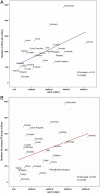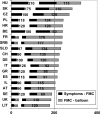Reperfusion therapy for ST elevation acute myocardial infarction in Europe: description of the current situation in 30 countries
- PMID: 19933242
- PMCID: PMC2854523
- DOI: 10.1093/eurheartj/ehp492
Reperfusion therapy for ST elevation acute myocardial infarction in Europe: description of the current situation in 30 countries
Abstract
Aims: Patient access to reperfusion therapy and the use of primary percutaneous coronary intervention (p-PCI) or thrombolysis (TL) varies considerably between European countries. The aim of this study was to obtain a realistic contemporary picture of how patients with ST elevation myocardial infarction (STEMI) are treated in different European countries.
Methods and results: The chairpersons of the national working groups/societies of interventional cardiology in European countries and selected experts known to be involved in the national registries joined the writing group upon invitation. Data were collected about the country and any existing national STEMI or PCI registries, about STEMI epidemiology, and treatment in each given country and about PCI and p-PCI centres and procedures in each country. Results from the national and/or regional registries in 30 countries were included in this analysis. The annual incidence of hospital admission for any acute myocardial infarction (AMI) varied between 90-312/100 thousand/year, the incidence of STEMI alone ranging from 44 to 142. Primary PCI was the dominant reperfusion strategy in 16 countries and TL in 8 countries. The use of a p-PCI strategy varied between 5 and 92% (of all STEMI patients) and the use of TL between 0 and 55%. Any reperfusion treatment (p-PCI or TL) was used in 37-93% of STEMI patients. Significantly less reperfusion therapy was used in those countries where TL was the dominant strategy. The number of p-PCI procedures per million per year varied among countries between 20 and 970. The mean population served by a single p-PCI centre varied between 0.3 and 7.4 million inhabitants. In those countries offering p-PCI services to the majority of their STEMI patients, this population varied between 0.3 and 1.1 million per centre. In-hospital mortality of all consecutive STEMI patients varied between 4.2 and 13.5%, for patients treated by TL between 3.5 and 14% and for patients treated by p-PCI between 2.7 and 8%. The time reported from symptom onset to the first medical contact (FMC) varied between 60 and 210 min, FMC-needle time for TL between 30 and 110 min, and FMC-balloon time for p-PCI between 60 and 177 min.
Conclusion: Most North, West, and Central European countries used p-PCI for the majority of their STEMI patients. The lack of organized p-PCI networks was associated with fewer patients overall receiving some form of reperfusion therapy.
Figures






References
-
- Zijlstra F, de Boer MJ, Hoorntje JC, Reiffers S, Reiber JH, Suryapranata H. A comparison of immediate coronary angioplasty with intravenous streptokinase in acute myocardial infarction. N Engl J Med. 1993;328:680–684. - PubMed
-
- Vermeer F, Oude Ophuis AJ, van den Berg EJ, Brunninkhuis LG, Werter CJ, Boehmer AG, Lousberg AH, Dassen WR, Bär FW. Prospective randomised comparison between thrombolysis, rescue PTCA, and primary PTCA in patients with extensive myocardial infarction admitted to a hospital without PTCA facilities: a safety and feasibility study. Heart. 1999;82:426–431. - PMC - PubMed
-
- Widimský P, Groch L, Zelízko M, Aschermann M, Bednár F, Suryapranata H. Multicenter randomized trial comparing transport to primary angioplasty vs immediate thrombolysis vs combined strategy for patients with acute myocardial infarction presenting to a community hospital without a catheterization laboratory. The PRAGUE study. Eur Heart J. 2000;21:823–831. - PubMed
-
- Widimsky P, Budesinsky T, Vorac D, Groch L, Zelizko M, Aschermann M, Branny M, St'asek J, Formanek P ‘PRAGUE’ Study Group Investigators. Long distance transport for primary angioplasty vs. immediate thrombolysis in acute myocardial infarction. Final results of the randomized national multicentre trial—PRAGUE-2. Eur Heart J. 2003;24:94–104. - PubMed
-
- Andersen HR, Nielsen TT, Rasmussen K, Thuesen L, Kelbaek H, Thayssen P, Abilgaard U, Pedersen F, Madsen JK, Grande P, Villadsen AB, Krusell LR, Haghfelt T, Lomholt P, Husted SE, Vigholt E, Kjaergard HK, Mortensen LS. A comparison of coronary angioplasty with fibrinolytic therapy in acute myocardial infarction. N Engl J Med. 2003;349:733–742. - PubMed
Publication types
MeSH terms
LinkOut - more resources
Full Text Sources
Medical
Miscellaneous

